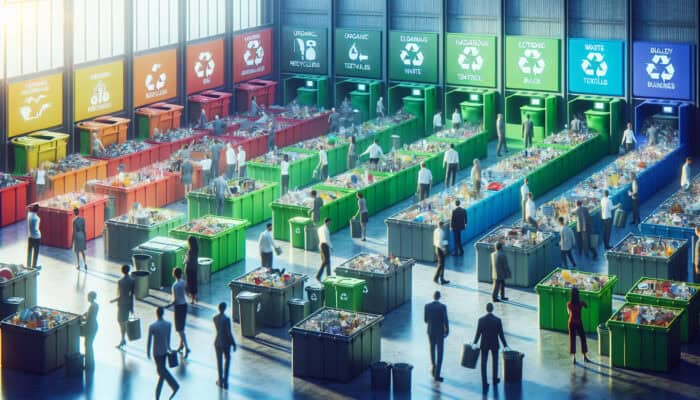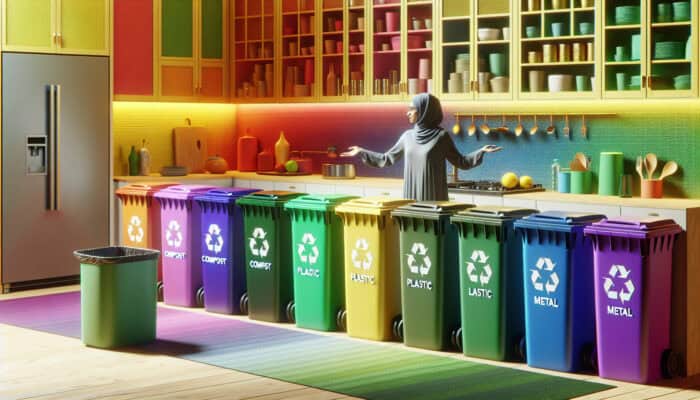Ultimate Guide to Efficient Waste Sorting in Clearances
What is Waste Sorting and What Makes It Crucial for Sustainability?

Best Bins for Waste Sorting in Clearances: Waste sorting refers to the systematic process of categorising various types of waste materials to enhance recycling efforts and ensure responsible disposal practices. This essential practice plays a pivotal role in advancing environmental sustainability and requires a solid understanding of the different categories of waste. Common waste categories include:
- Recyclables (for instance, plastic, paper, glass)
- General waste (consisting of non-recyclable materials)
- Organic waste (which includes food scraps and garden refuse)
- Hazardous materials (such as batteries and chemicals)
- E-waste (relating to electronic devices)
- Construction debris
- Textiles (including clothing and fabric)
- Bulk waste (comprising large items like furniture)
By effectively sorting waste, we not only simplify the disposal process but also maximise recycling potential, significantly reducing landfill usage and lessening the environmental impact associated with improper waste disposal.
Understanding the Importance of Clearances in Waste Management
Clearances play an essential role in waste management by designating specific areas for sorting and disposal, which significantly contributes to enhancing community cleanliness and orderliness. The benefits of incorporating clearances into waste management practices encompass:
- Better organisation of various waste materials
- Reduction of contamination in recyclable waste
- Improved community health and hygiene standards
- Efficient processes for waste collection
- Heightened awareness and active participation in recycling initiatives
- Support for local environmental policies
- Encouragement of responsible waste disposal habits among residents
- Provision of a more visually appealing environment in public spaces
By embracing clearances, communities can foster a culture of sustainability and collective responsibility regarding waste management, resulting in a cleaner and greener living environment for all.
Examining Varied Bin Types Used for Effective Waste Sorting in Clearances
A myriad of bins are specifically designed to cater to distinct waste categories, with each type serving a unique function in effective waste management. These bins are vital for successful sorting and include: recycling bins, general waste bins, organic waste bins, and hazardous waste containers. Recycling bins, typically identifiable by blue or green colours, are designated for materials that can be recycled, including paper, cardboard, and certain types of plastics. General waste bins, generally in black, are reserved for items that cannot be recycled. Organic waste bins, often brown or green, are intended for compostable materials, while hazardous waste containers are distinctly labelled to indicate their contents, ensuring safe disposal procedures. Understanding the specific roles of each bin type is crucial for effective waste sorting, ultimately leading to improved recycling rates and reduced landfill waste.
Expert Insights on the Most Effective Bins for Waste Sorting in Clearances

How Can You Select the Most Suitable Bins for Waste Sorting?
When it comes to selecting bins for waste sorting in clearances, experts suggest considering several critical factors. These factors encompass the size of the bin, the material from which it is made, and its sorting capabilities. Choosing the right size is essential to ensure that bins can accommodate the expected volume of waste without overflowing, which could lead to contamination and hygiene concerns. The choice of material also affects the bin's durability and longevity; for example, plastic bins are lightweight and resistant to rust, while metal bins offer greater durability but may require more maintenance. Sorting capabilities, such as the number of compartments, facilitate the efficient separation of various waste types, prompting users to engage in proper disposal practices.
Real-world examples from different locations across the UK illustrate the effectiveness of choosing bins thoughtfully. For instance, a local council in Manchester implemented dual-compartment bins in public parks to enhance source sorting, leading to a remarkable increase in recycling rates of up to 40%. This successful case exemplifies how tailored bin selections can positively influence community participation in waste sorting initiatives.
What Key Features Should High-Quality Bins Incorporate?
High-quality bins should incorporate several essential features to ensure they are effective and easy to use. Firstly, durability is vital; bins should withstand various weather conditions and potential vandalism. Additionally, bins must be weather-resistant, given the unpredictable UK climate, to prevent deterioration over time. Clear labelling is also crucial; bins should have prominent, easy-to-read labels that guide users in correctly sorting their waste.
To evaluate bin quality before making a purchase, one can follow actionable steps such as examining the material for robustness, checking for user-friendly features like foot pedals or lids, and ensuring that the bin is easy to clean. Furthermore, selecting bins with colour-coded compartments can simplify the sorting process, allowing users to quickly identify where to discard their waste. Investing in high-quality bins guarantees a longer lifespan and a more efficient waste management process.
Strategic Strategies for Optimal Bin Placement in Clearances

Strategically placing bins is crucial for improving sorting efficiency and encouraging user compliance. Expert recommendations suggest that bins should be located in high-traffic areas where they are easily visible and accessible. Positioning bins in close proximity to one another can also promote users to take the initiative to sort their waste appropriately.
Another effective strategy involves implementing educational signage alongside bins, illustrating what can and cannot be disposed of in each bin. For example, placing recycling bins near building entrances can lead to higher sorting rates, as individuals are more likely to participate when they see the bins readily available. Furthermore, adapting bin placement based on specific events or seasonal variations can further optimise waste sorting practices; therefore, it is essential to regularly analyse usage patterns to inform future placements.
How Can Technology Transform Waste Sorting Techniques in Bins?
Technology is revolutionising the effectiveness of waste sorting in bins. Solutions like smart bins equipped with sensors can indicate when they are full, ensuring timely collection and maintenance. Additionally, certain bins feature smart labels that guide users on proper sorting through QR codes or digital displays. This technology can provide real-time data on waste levels and types, facilitating more effective inventory management and planning.
In the UK, bins equipped with these advanced technologies have been deployed in major cities, demonstrating significant improvements in waste segregation and overall management. For example, a pilot project in London introduced smart recycling bins that communicate with local authorities, ensuring collections take place just in time, thus significantly reducing overflow and contamination rates. By leveraging technological advancements, municipalities can greatly enhance their waste management practices, leading to more effective sorting and disposal solutions.
Top Bin Models for Efficient Waste Sorting
What Are the Most Preferred Bin Models Available on the Market?
Across the UK, numerous bin models have gained popularity due to their durability, design, and effectiveness in facilitating waste sorting. Renowned brands such as Simplehuman and Brabantia are leaders in the market, providing a diverse range of bins tailored for various waste categories. For instance, Simplehuman’s recycling bin features dual compartments with a robust design, making it suitable for both households and offices. Brabantia’s iconic Touch Bin is another sought-after choice, celebrated for its sleek aesthetics and efficient waste sorting capabilities.
Key features found in top bin models include:
- Dual-compartment designs for straightforward sorting
- Foot-pedal operation for hands-free usage
- Durable, corrosion-resistant materials
- Clear labelling and colour-coded sections
- Odour-proof lids for hygienic disposal
- Easy-to-clean designs with detachable inner buckets
- Construction from recycled materials for eco-friendliness
- Customisable sizes to fit various spaces
These models not only support effective waste segregation but also seamlessly integrate into modern homes and workplaces, promoting responsible disposal practices among users.
How Do Various Bin Materials Compare in Performance?
Bins can be manufactured from a variety of materials, including plastic, metal, and wood, each offering distinct advantages concerning durability, cost, and environmental impact. Plastic bins are lightweight and resistant to rust, making them ideal for outdoor applications; however, they may not always match the durability of metal alternatives. Metal bins, often constructed from stainless steel, provide superior durability and longevity; however, they can be more expensive and may require regular maintenance to prevent corrosion.
Wooden bins, while aesthetically pleasing and suitable for specific environments, may not offer the same level of weather resistance as plastic or metal options. Furthermore, they can be more challenging to clean and maintain. Ultimately, the choice of material should reflect not only the intended use of the bin but also the community’s environmental considerations, thereby promoting sustainable waste management practices.
Where Can You Acquire Bins for Waste Clearances?
Bespoke bins for waste sorting can be sourced from various outlets across the UK, ranging from local hardware stores to specialist waste management suppliers. Online retailers such as Amazon or eBay also provide a broad selection of bin models and materials, often including customer reviews to assist in purchasing decisions. Additionally, many councils offer information on approved suppliers that meet local waste management standards, ensuring that bins obtained contribute to effective waste sorting efforts.
Specialised waste management suppliers frequently offer customisation options, allowing customers to select features that align with their specific needs, such as colour coding or additional compartments. It is advisable to compare prices and features from multiple sources to ensure an informed choice that meets both budgetary and functional requirements.
Key Benefits of Using Bins for Waste Sorting in Clearances
How Does Effective Waste Sorting Enhance Environmental Health?
Efficient waste sorting plays a vital role in improving environmental health by decreasing landfill waste and increasing recycling rates. When waste materials are sorted properly, recyclable items are diverted from landfills, thereby reducing the total volume of waste. This essential process not only conserves natural resources but also mitigates greenhouse gas emissions associated with waste decomposition in landfills.
The environmental benefits of proper waste sorting include:
- Reduced landfill size and associated methane emissions
- Conservation of natural resources through robust recycling efforts
- Lowered energy consumption in the production of recycled products
- Enhanced air and water quality by minimising hazardous waste
- Promotion of biodiversity by limiting habitat destruction due to mining and raw material extraction
- Encouragement of sustainable community practices and heightened awareness
- Reduction in the overall environmental footprint of waste management systems
- Support for local recycling initiatives and efforts
By prioritising effective waste sorting, communities can take significant strides towards achieving environmental sustainability and fostering a healthier planet for future generations.
What Economic Advantages Can Be Realised Through Waste Sorting?
Waste sorting presents notable economic advantages, particularly in terms of cost savings and potential revenue generation. By minimising the amount of waste sent to landfills, facilities can significantly reduce disposal fees, which can be quite substantial in urban areas. Enhanced sorting can also yield increased volumes of recyclable materials collected, creating opportunities for revenue through the sale of these materials to recycling facilities.
Moreover, efficient waste sorting systems can lead to decreased operational costs for waste management companies, as more materials are processed for recycling rather than being disposed of. These savings can ultimately be reinvested into community programs or infrastructure improvements, further enhancing local economic stability. Through strategic waste sorting initiatives, communities can enjoy economic benefits while simultaneously promoting sustainable practices and behaviours.
How Does Waste Sorting Contribute to Community Well-Being?
Proper waste sorting during clearances fosters community pride and responsibility, resulting in cleaner and more aesthetically pleasing living environments. When community members actively engage in effective waste sorting, they cultivate a sense of ownership over their surroundings, which can strengthen communal bonds and enhance the overall quality of life. Well-maintained clearances not only reflect positively on neighbourhoods but can also attract visitors and potentially boost local businesses.
Additionally, clean environments have been linked to improved mental health and well-being, fostering a sense of safety and security among residents. By promoting waste sorting initiatives, communities can nurture a culture of sustainability and social responsibility, resulting in a cleaner environment and a stronger sense of community cohesion and belonging.
Research-Driven Insights on the Best Bins for Waste Sorting in Clearances
What Do Studies Indicate About Bin Efficiency?
Research indicates that well-designed bins significantly enhance recycling rates while simultaneously reducing contamination levels. Studies show that clear and intuitive designs, including colour coding and appropriate labelling, elevate user compliance, leading to improved sorting outcomes. Effectively structured waste management systems equipped with thoughtfully designed bins can boost recycling rates by as much as 60%, underscoring the critical impact that bin design has on sorting efficiency.
Expert analyses confirm that the arrangement and features of bins directly influence user behaviour, promoting correct waste disposal practices. Therefore, investing in high-quality, thoughtfully designed bins is essential for effective waste management strategies in clearances.
How Does Bin Design Influence User Behaviour?
Bin design plays a crucial role in determining how users sort their waste, encouraging better compliance with sorting practices. Elements such as colour coding and clear labelling can significantly influence user behaviour, as individuals are more inclined to participate when the sorting process is straightforward and intuitive. Aesthetically pleasing and user-friendly bins can motivate participation, as they create a positive experience for users.
Furthermore, research has shown that bins equipped with visual prompts or instructional signage can enhance sorting practices, as users receive clear guidance on how to dispose of their waste correctly. By refining the design and functionality of bins, communities can foster a culture of responsible waste disposal, leading to enhanced recycling rates and decreased contamination levels.
What Are the Long-Term Benefits of Investing in Quality Bins?
Quality bins offer not only immediate advantages in terms of durability and functionality but also promote consistent waste sorting habits over time. When communities invest in high-quality bins, they are more likely to embrace sustainable waste management practices, resulting in lasting environmental and economic benefits. Durable bins that withstand the test of time reduce the need for frequent replacements, thereby minimising waste generation.
Moreover, quality bins instil a sense of accountability among users, as individuals are more likely to respect and utilise well-maintained, efficient systems. This adherence to proper waste sorting practices can create a positive feedback loop, reinforcing responsible behaviours and leading to sustained improvements in recycling rates and community engagement over time.
How Can Optimal Bin Placement Enhance Waste Sorting Practices?
Strategic bin placement is essential for improving accessibility and visibility, which directly impacts user engagement and effective waste sorting practices. Bins should be positioned in high-foot traffic areas, ensuring they are conveniently located for users to facilitate proper waste disposal. Placing bins near communal areas, parks, or event spaces can significantly enhance sorting efficiency, as they are readily available when individuals are most likely to generate waste.
Regular analysis of bin usage patterns can inform placement strategies, allowing communities to adapt their approaches based on user behaviour. Additionally, incorporating educational signage alongside bins can further engage users and promote responsible waste disposal practices. By prioritising optimal bin placement, communities can establish effective waste management systems that encourage sorting compliance and enhance overall waste management efforts.
What Role Do Bins Play in Achieving Corporate Sustainability Objectives?
Bins designed for effective waste sorting are integral to fulfilling corporate sustainability goals, significantly contributing to waste reduction and recycling initiatives. By providing accessible and clearly labelled waste disposal options, businesses can encourage employees and customers to engage in sustainable practices. Implementing a robust waste sorting system demonstrates a commitment to environmental stewardship and can enhance a company’s public image.
Moreover, effective waste management can lead to substantial cost savings for enterprises, reinforcing the economic rationale for investing in quality sorting bins. Aligning waste sorting initiatives with corporate sustainability objectives not only supports environmental efforts but also fosters a culture of responsibility and accountability among employees, ultimately contributing to a more sustainable future.
Practical Steps for Implementing Waste Sorting in Clearances
How Can You Create an Effective Waste Sorting System?
Establishing an effective waste sorting system involves several key steps that focus on user engagement and accessibility. To create a successful sorting system, consider the following steps:
- Select appropriate bins tailored to specific waste categories
- Educate users about sorting guidelines and correct disposal practices
- Maintain regular communication to reinforce sorting objectives
- Implement visual aids and informative signage alongside bins
- Conduct regular monitoring and reviews of the system to identify areas for enhancement
- Encourage community involvement in the waste sorting process
- Facilitate easy access to bins in high-traffic locations
- Ensure consistent maintenance and cleanliness of bins
Establishing a clear framework encourages users to actively participate in the waste sorting process, leading to improved recycling rates and increased community engagement in sustainable practices.
What Common Obstacles Are Encountered in Waste Sorting Initiatives?
Common obstacles in waste sorting include user non-compliance, contamination of recyclable materials, and maintenance challenges that can hinder effective waste sorting practices. User non-compliance often stems from a lack of knowledge or understanding of sorting procedures, while contamination can occur when non-recyclable items are mistakenly placed in recycling bins. Proper planning and comprehensive education are crucial in addressing these challenges.
To mitigate these issues, community leaders can initiate educational campaigns aimed at raising awareness about correct waste sorting practices. Regular feedback mechanisms can also help identify persistent challenges, allowing for targeted interventions to enhance user compliance. Furthermore, periodic inspections of bin contents can provide insights into common sorting mistakes, informing future educational initiatives and improving overall sorting efficacy.
How Can You Ensure Bins Are Maintained for Long-Term Use?
Routine cleaning and inspections are vital for preserving the functionality and hygiene of bins over time. A well-maintained bin system not only serves its purpose effectively but also promotes a positive user experience. Establishing a consistent maintenance schedule can help identify issues before they escalate, ensuring that bins are emptied promptly and cleaned regularly.
Engaging community members in maintenance efforts can foster a sense of ownership, encouraging them to take responsibility for the cleanliness of their environment. This participation can lead to heightened community pride and a greater commitment to sustaining effective waste sorting practices, ultimately culminating in long-term success in waste management initiatives.
Emerging Trends in Waste Sorting and Clearances
What Innovations Are Shaping Waste Sorting Practices?
Innovations such as smart bins equipped with sensors and automated sorting systems are transforming waste management practices. Smart bins can provide valuable data on waste levels, enabling efficient collection schedules and preventing overflow issues. Additionally, automated sorting technologies are being developed to improve the efficiency of recycling facilities, allowing for faster processing and improved quality of recycled materials.
Moreover, emerging technologies like artificial intelligence and machine learning are being integrated into waste management systems to enhance sorting accuracy and reduce contamination rates. These advancements present promising solutions to current challenges in waste sorting, paving the way for a more sustainable future.
How Will Legislation Influence Future Waste Sorting Practices?
Future legislation is anticipated to impose stricter waste sorting requirements, impacting the design and usage of bins during clearances. As governments place higher importance on environmental sustainability, regulations may mandate increased recycling targets and comprehensive waste management systems. These changes will necessitate the development of more sophisticated and efficient bin designs that facilitate compliance with new standards.
Additionally, local councils may be prompted to invest in educational initiatives to inform residents about legislative changes and their implications for waste sorting practices. By proactively adapting to regulatory trends, communities can refine their waste management strategies, ensuring compliance and fostering a culture of responsibility and sustainability.
What Effect Will Public Awareness Have on Waste Sorting Initiatives?
Increased public awareness and education will be crucial in driving effective waste sorting practices across the UK. As communities become more informed about the environmental impacts of waste and the significance of recycling, participation rates in waste sorting initiatives are expected to rise. Educational campaigns can highlight the advantages of proper waste sorting, instilling a sense of responsibility and community pride among residents.
Utilising various communication channels, including social media, community meetings, and local events, can effectively disseminate information and encourage engagement. By prioritising public awareness, communities can cultivate a culture of sustainability and collective action, ultimately leading to more successful outcomes in waste management practices.
FAQs on Waste Sorting and Bin Usage
What is waste sorting?
Waste sorting is the method of separating various types of waste materials to optimise recycling and ensure proper disposal, thereby enhancing environmental sustainability.
Why are clearances important?
Clearances provide designated areas for sorting and disposal, contributing to cleanliness, reducing contamination, and promoting effective waste management practices.
What types of bins are used in clearances?
Bins for clearances are typically categorised into recyclables, general waste, organic waste, and hazardous materials, each serving a specific purpose in waste management.
How do you choose the right bins for waste sorting?
When selecting bins, consider factors such as bin size, material, and sorting capabilities. Opt for durable, weather-resistant options with clear labelling to enhance user compliance.
What features should high-quality bins have?
High-quality bins should be durable, user-friendly, weather-resistant, and clearly labelled to encourage proper waste sorting practices.
What are the challenges faced in implementing waste sorting systems?
Common challenges include user non-compliance, contamination of recycling materials, and maintenance issues that can hinder effective waste sorting practices.
How does waste sorting benefit the environment?
Waste sorting reduces landfill waste, increases recycling rates, conserves natural resources, and contributes to better air and water quality for communities.
What are the economic advantages of waste sorting?
Waste sorting can lead to cost savings in waste management and potential revenue from recyclable materials, benefiting both communities and businesses.
How can community members support waste sorting initiatives?
Community members can engage in educational efforts, actively participate in waste sorting, and promote awareness of proper disposal practices to support initiatives.
What future trends are emerging in waste sorting?
Emerging trends include the adoption of smart bins equipped with sensors, automated sorting systems, and increased public awareness initiatives aimed at enhancing waste management practices.
Connect with us on Facebook!
The Article: Best Bins for Waste Sorting in Clearances: UK Edition Was First Found At https://birminghamhouseclearance.com
The Article Bins for Waste Sorting: Top Choices for Clearances in the UK Was Found On https://limitsofstrategy.com

